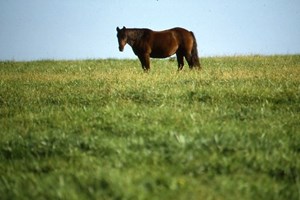Challenges of Cushing’s diagnosis
- July 25, 2019
- ⎯ Equus
Q:

I live in Canada, and I own four horses ranging from 6 to 25 years old. By late spring last year, they had all shed their winter hair and had beautiful slick coats, except for my 22-year-old Trakehner-cross mare. She was recently tested for Cushing’s disease, but the tests were negative. What else could be causing her not to shed?
Name Withheld By Request
A:
This is a very important question. Our understanding of equine Cushing’s disease, also known as PPID (pituitary pars intermedia dysfunction), is advancing rapidly, but testing is still imperfect. The equine version of this disease is different from Cushing’s in other species in that for horses it is caused by changes in a specific portion of the pituitary gland. The pituitary then showers the body with a variety of hormones without the usual control and feedback. One effect of these hormones is to stimulate overproduction of the stress hormone cortisol from the adrenal glands, which in turn leads to imbalances in many other hormones that cause many of the outward signs of PPID. A long, shaggy winter coat that is slow to shed in the spring is a hallmark of PPID, but other early signs include decreased athletic performance, lethargy, changes in body shape and persistent, low-grade laminitis. In more advanced cases the horse may develop increased or decreased sweating, stubborn infections, slow-healing wounds or injuries, increased thirst and urination, and a host of other problems. This disease truly affects all aspects of a horse’s health.Many tests are currently available for PPID, and each has benefits and drawbacks. The ACTH (adrenocorticotropic hormone) test is very common now because it is safe and simple to perform. But because levels of this hormone can fluctuate at different times of year in normal horses, the results must be interpreted carefully. The most sensitive test we have is the TRH (thyrotropin-releasing hormone) stimulation test. For this test, the horse is given a dose of TRH and then a blood sample is taken 10 minutes later. (This test became commercially available in the United States in 2014, and I do not know if your veterinarian can get it in Canada.) As with ACTH, TRH levels may also vary with the seasons, so these results must also be interpreted carefully. Unfortunately, we do get false negatives on tests for PPID, which means the results say the horse does not have the disease when he really does. However, there really is nothing else that delays shedding like PPID can. I would recommend that you talk more with your veterinarian about this possibility. The earlier a horse with PPID is started on medication, the better it will be for his health. In some cases, we might start the medication based solely on the fact that the horse is not shedding; other times, we might go to more advanced testing. This can be done on the farm or in a referral center.Medical treatment for PPID is a daily dose of pergolide mesylate (trade name Prascend). This medication controls the disease but does not cure it. Over time, if the disease advances we may need to adjust the medication dosage, so additional testing will be needed in the future.In addition to medication, good management is important. Even if you start treatment right away, it will take time for your mare to normalize. In the meantime, clip her excess coat, keep her cool in warmer weather, and monitor her closely for infections and changes in body shape. Staying on top of changes and communicating often with your veterinarian will let you keep her healthy and happy for many more years to come.
Melinda Freckleton, DVM Haymarket Veterinary Service Gainesville, Virginia
This month’s expert: Melinda Freckleton, DVM, is a veterinarian at Haymarket Veterinary Service in Gainesville, Virginia. A graduate of Cornell University’s College of Veterinary Medicine, Freckleton enjoys riding and competing in dressage and taking care of her dogs, cats and horses on her small farm.
This article first appeared in EQUUS issue #468, September 2016.





